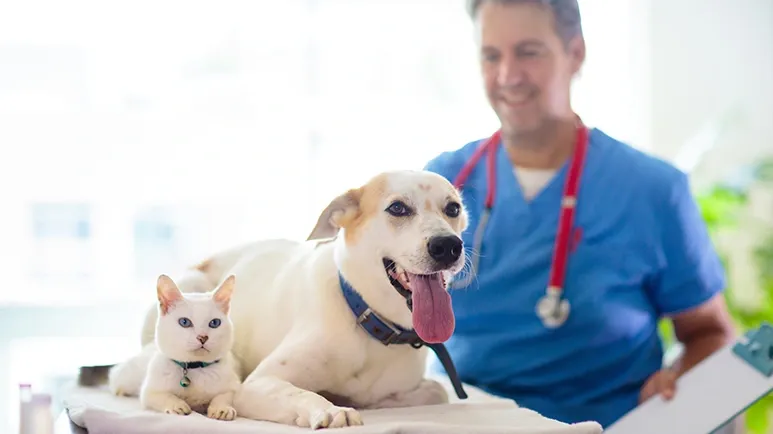Oxygen Secrets That Help Pets Heal Naturally
Could oxygen be the missing link in your pet's healing? Learn how this natural therapy is transforming veterinary care.

STORY AT-A-GLANCE
- Ozone and Prolozone therapies use oxygen's natural power to repair tissues, fight infection, and reduce inflammation in pets
- These treatments help pets recover without harsh drugs or invasive surgery, supporting the body's own healing process
- From arthritis and joint pain to wounds, infections, and even cancer support, oxygen therapy offers wide-ranging benefits
- Prolozone supercharges recovery — by combining ozone with vitamins and nutrients, it stimulates collagen growth, restores mobility, and relieves chronic pain
- When performed by trained veterinarians, oxygen-based therapies help pets regain comfort, balance, and vitality, naturally
When you think about healing, you probably imagine medicine, rest, and maybe a little extra love. But what if one of the most powerful healing tools for your pet was something as simple and natural as oxygen? That's the secret behind oxygen therapy — cutting-edge, natural treatments that use this gas' incredible power to help pets recover from injuries, infections, inflammation, and even chronic diseases.
Across veterinary clinics worldwide, oxygen-based therapies are helping dogs, cats, horses, and even exotic pets heal faster, feel better, and return to their joyful, active selves, without heavy drugs or invasive surgeries.
The Healing Power of Oxygen
Every cell in your pet's body depends on oxygen. It fuels metabolism, powers immune defenses, and helps repair damaged tissues. When oxygen levels drop, whether from injury, inflammation, or poor circulation, healing slows down. That's where ozone therapy steps in.
Ozone is a form of oxygen made up of three oxygen atoms (O₃). In medicine, it's used in carefully controlled amounts to boost the body's oxygen use and trigger healing responses. When ozone enters the body, it interacts with blood plasma and tissues to:1
- Improve oxygen delivery to every cell
- Activate white blood cells that fight infection
- Stimulate the release of growth factors that repair tissues
- Boost antioxidant enzymes to control inflammation
- Support the production of new red blood cells and stem cells
In simpler terms, ozone helps your pet's body work smarter, not harder, by using oxygen more efficiently where it's needed most.
The Science Behind the Healing
You might wonder, how can something as simple as oxygen make such a big difference?
When cells are damaged or inflamed, their mitochondria, the energy factories of the body, slow down. They can't use oxygen efficiently, so healing stalls. Ozone therapy reverses that by delivering extra oxygen and stimulating those cells to start working again.
It also triggers the release of molecules like interferon and tumor necrosis factor, which help fight infections and even suppress cancer cell growth. At the same time, ozone increases antioxidant enzymes that protect tissues from further damage.
In short, ozone brings balance back to the system — giving the body the tools it needs to heal itself naturally.2
How Does Ozone Therapy Work?
In veterinary medicine, ozone therapy can be delivered in several ways, depending on what needs to be treated. A veterinarian trained in ozone therapy might use it as a gas, in ozonated water, or in a carrier like ozonated glycerin. The goal is always the same — to get oxygen-rich molecules directly to the area of the body that needs healing. Here are a few ways ozone is used in pets:
- Topical application — For wounds, burns, or skin infections, ozone-infused oils or gels are applied directly to the affected area.
- Ozone insufflation — A gentle introduction of ozone gas into body cavities or under the skin to support systemic healing.
- Ozonated saline or water — Used for flushing infected wounds or ears to reduce bacteria and inflammation.
- Injection (Prolozone) — Ozone combined with nutrients and natural compounds is injected near damaged joints or ligaments to repair tissue.
- Autohemotherapy — Ozone is combined with a small amount of a patient’s own blood and re-injected. This is useful for chronic systemic conditions.
- Limb bagging — For local wounds or injuries the area (on a limb) is isolated inside a bag and infused with ozone to directly enhance wound healing.
According to veterinarians who use this therapy, ozone can be a powerful supportive treatment not just for illness, but for recovery and prevention. It helps normalize cellular function, boosts circulation, and makes the body's natural defenses stronger.3
Why Ozone Therapy Is So Versatile
Ozone therapy isn't limited to one type of condition — it's used across many systems of the body. Veterinarians use it for everything from skin infections to chronic pain, respiratory conditions, inflammation, and immune disorders. Common applications include:4
- Antibacterial and antiviral therapy — Ozone kills harmful microorganisms but leaves healthy cells unharmed.
- Immune system support — By stimulating white blood cells and modulating inflammation, ozone helps restore balance in immune function.
- Pain relief and inflammation control — Especially useful in arthritis, tendonitis, and degenerative joint disease.
- Circulatory and wound healing support — Ozone increases oxygen flow to tissues, helping stubborn wounds heal faster.
- Dental care and ear infections — Ozone water and oils can have an antimicrobial effect without the use of harsh chemicals.
It's also used in neurological conditions, urinary issues, and even to support the microbiome and gut health. For many pets, ozone therapy becomes part of a whole-body wellness plan.
Ozonated Glycerin — A Gentle, Powerful Oxygen Carrier
One of the most exciting innovations in veterinary ozone therapy is ozonated glycerin, a stable, water-friendly carrier that holds ozone safely until it reaches the body's tissues.
Unlike gaseous ozone, which needs to be used immediately after generation, ozonated glycerin can be applied topically, injected, or even used intravenously under veterinary supervision. This makes it incredibly versatile for pets of all species, from cats and dogs to horses, birds, and reptiles.
Ozonated glycerin has antimicrobial, anti-inflammatory, and immune-modulating effects. It's used to support:
- Wound healing — Including chronic, non-healing wounds, ulcers, burns, and surgical sites.
- Dental care — For gingivitis, oral ulcers, tooth abscesses, and post-extraction healing.
- Skin infections — Hot spots, abscesses, and fungal infections.
- Eye care — For corneal ulcers and conjunctivitis.
- Cancer support — Intratumoral ozone injections help oxygenate tumor tissue, making it less hospitable to cancer cells and easing inflammation.
- Joint and muscle recovery — Helps relieve pain and stiffness from injuries or arthritis.
- Neurologic and immune disorders — Supports nerve recovery and immune regulation.
Because ozonated glycerin is gentle on tissues and mucous membranes, it's safe even for sensitive areas like the mouth, eyes, and ears. However, it should always be administered by a veterinarian trained in ozone therapy to ensure proper technique and safety.5
From Prolotherapy to Prolozone — Regenerating Damaged Tissue
While ozone therapy focuses on boosting oxygen and immune function, another therapy, Prolotherapy, takes a different but complementary approach — stimulating the body's natural repair systems through mild, targeted inflammation.
In prolotherapy, your veterinarian injects a natural solution (often dextrose or saline) into injured or weakened areas such as tendons or ligaments. This mild irritation "wakes up" the body's repair system, signaling it to send new cells, nutrients, and collagen to the site.6
Over time, this process strengthens and stabilizes the joint. Prolotherapy has been especially helpful for pets with ligament injuries, chronic back or hip pain, and early arthritis. It's safe, relatively simple, and typically requires only a few treatments for noticeable improvement.
Enter Prolozone — Supercharging Healing with Oxygen
Prolozone therapy is the next step in regenerative healing. It combines the tissue-regenerating benefits of prolotherapy with the oxygen-boosting power of ozone.
Here's how it works — After injecting a prolotherapy solution (usually a combination of dextrose, B vitamins, a numbing agent and a homeopathic remedy) into the affected area, the veterinarian follows with a small injection of ozone gas.7,8
The ozone increases oxygen use, stimulates circulation, and triggers the production of healthy new tissue. It's like giving your pet's joints an oxygen-rich energy boost that helps them rebuild from the inside out. Below are the benefits your pets can get from Prolozone therapy.
- Repairs damaged ligaments and cartilage (ACL injuries, hip and knee arthritis, and spinal pain)
- Relieves chronic pain
- Improves mobility
- Promotes collagen growth
Prolozone therapy has low risk and minimal side effects, such as mild soreness or swelling for 24 to 48 hours, which is typical. Many pet owners notice improvement after the first treatment, though two to four sessions may be needed for full benefit.9 And because Prolozone addresses the root cause (damaged tissue), it can provide long-term results, not just temporary relief.
Together, these treatments complement one another. Oxygen from ozone fuels healing, while prolotherapy's stimulation directs where that healing takes place.
Conditions That May Benefit
Oxygen-based therapies can help a wide variety of conditions in pets, especially those involving pain, inflammation, or chronic conditions. According to veterinary ozone therapy protocols, ozone, Prolozone, and ozonated glycerin have been used for:10,11
- Musculoskeletal problems — Arthritis, hip dysplasia, ligament injuries, tendonitis, and back pain.
- Chronic infections — Ear, skin, or dental infections that resist antibiotics.
- Wound care — Burns, abscesses, and surgical recovery.
- Neurologic issues — Nerve inflammation and diseases affecting the brain and spinal cord.
- Cancer support — Enhances the immune system response in cancer patients.
- Systemic or immune disorders — Chronic fatigue, inflammation, allergies, and viral infections.
These therapies don't replace traditional veterinary medicine but can enhance it — helping pets recover faster and more completely.
What a Treatment Looks Like
If your veterinarian recommends ozone or Prolozone therapy, here's what you can expect:
- Your vet will evaluate your pet's condition, reviewing medical history, X-rays, and any prior treatments.
- Based on the condition, the vet decides which form of ozone to use — gas, ozonated glycerin, or injections.
- For ozone therapy, your pet may receive an infusion, wound treatment, or topical application. For Prolozone, the injection site is numbed, and a small amount of ozone plus prolotherapy solution is injected.
- Most pets experience mild soreness for a day or two. Gentle movement or light exercise helps circulation and supports healing.
- Depending on severity, two to four treatments are typical, spaced a few weeks apart.
Many pets show improvement after the first visit. They're walking easier, showing less pain, or having more energy.
Is Oxygen Therapy Safe?
Veterinarians are increasingly turning to oxygen-based therapies because they support the body's innate intelligence — its built-in ability to heal itself. When performed by a licensed veterinarian trained in ozone therapy, these treatments are considered safe and well-tolerated.12,13
Side effects are rare but may include temporary swelling, mild discomfort at the injection site, or fatigue for a day or two. Because ozone is a gas, it should be handled carefully to avoid inhalation, which is another reason to trust only qualified professionals.
For the right patient, however, ozone and Prolozone therapies can mean faster recovery, less pain, and fewer medications. Instead of forcing a chemical reaction or masking symptoms, ozone and Prolozone encourage balance, circulation, and regeneration. They can work alongside conventional treatments like antibiotics, surgery, or physical therapy to boost results.
A Word of Caution
While ozone and Prolozone are natural, they're not do-it-yourself treatments. The concentration, dosage, and method of administration are critical. Improper use can be dangerous. Always work with a veterinarian who has specific training and certification in ozone therapy.
Ask about their experience, success rates, and how ozone fits into your pet's overall treatment plan. A knowledgeable vet will guide you safely, ensuring your pet gets the full benefit of this powerful natural therapy.
Oxygen — Let Your Pet Experience the Benefits of Nature's Medicine
From chronic pain to infections and slow-healing wounds, ozone and Prolozone therapies offer a safe, natural, and science-backed way to help your pet heal from the inside out. They don't just mask symptoms — they empower the body's own healing systems to restore balance and vitality.
So the next time you see your pet struggling with stiffness, skin problems, or recovery after surgery, remember that healing might just be a breath of oxygen away.
Sources and References
- 1,3,4,5,7,10,13 Regeno3one Vet, Ozone Therapy for Animals
- 2,11 Florida Wild, Ozone and Prolozone Therapy
- 6,8,9,12 Dr. Jyl Rubin DVM, Prolotherapy










